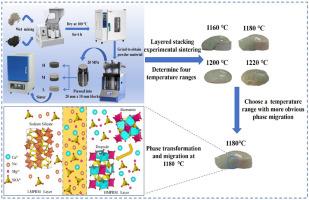高炉矿渣与多种固体废弃物制备泡沫陶瓷的共熔机理
IF 5.6
2区 材料科学
Q1 MATERIALS SCIENCE, CERAMICS
引用次数: 0
摘要
目前对泡沫陶瓷制备的研究主要集中在单个固体废物或简单的混合体系上。目前还缺乏对多种复杂固体废物协同反应机理的系统分析,以及对多组分固体废物系统中物质迁移途径的全面研究。为了系统研究高炉炉渣与多种固体废弃物联合制备泡沫陶瓷的烧结反应机理,为此,将原料分为高熔点和低熔点固体废弃物混合物,通过热力学计算和熔点实验确定共晶温度范围为1160-1220℃。通过层状共晶实验,利用x射线衍射分析、扫描电镜等分析方法研究温度梯度下非均相界面的相变规律和结构演化特征。结果表明:在1180℃时,高、低熔点固废混合物共晶区形成以透辉石为主晶相的稳定结构和均匀分布的孔隙结构;Na+在低熔点固废混合物中的扩散可以显著降低CaO-SiO2-Al2O3-MgO体系的液相形成温度,形成的硅酸盐熔体可以不断腐蚀高熔点固废混合物的固体颗粒,促进共晶区透辉石相和辉石相的合成。这种“固液侵蚀”效应不仅优化了熔体粘度与表面张力的匹配关系,而且通过调节离子迁移速率实现了对孔隙结构的精确控制。本研究通过层状共晶实验和材料迁移路径研究,从多相界面反应动力学的角度阐明了多组分固体废弃物协同制备泡沫陶瓷的机理。该研究为开发新型固体废物基轻质高强度陶瓷材料提供了理论基础。本文章由计算机程序翻译,如有差异,请以英文原文为准。

Co-melting mechanism of foam ceramics prepared using blast furnace slag and multiple solid wastes
Current research on the preparation of foam ceramics predominantly centers on individual solid waste materials or simple mixed systems. There is a notable absence of systematic analysis regarding the synergetic reaction mechanisms of multiple complex solid wastes, as well as comprehensive studies on the material migration pathways in multi-component solid waste systems. To systematically investigate the sintering reaction mechanism for preparing foam ceramics using blast furnace slag in conjunction with multiple solid wastes, to this end, raw materials were divided into high- and low-melting-point solid waste mixtures, and a eutectic temperature range of 1160–1220 °C was determined through thermodynamic calculations and melting point experiments. Layered eutectic experiments were performed, and X-ray diffraction analysis, scanning electron microscopy, and other analysis methods were used to study the phase transition law and structural evolution characteristics of heterogeneous interfaces under temperature gradients. The results indicate that, at 1180 °C, eutectic zones of high- and low-melting-point solid waste mixtures form a stable structure with diopside as the main crystalline phase and uniformly distributed pore structures. The diffusion of Na+ in the low-melting point solid waste mixture can significantly reduce the liquid phase formation temperature of the CaO-SiO2-Al2O3-MgO system, and the resulting silicate melt can continuously corrode the solid particles of the high-melting point solid waste mixture, promoting the synthesis of diopside and pyroxene phases in the eutectic zone. This “solid–liquid erosion” effect not only optimizes the matching relationship between melt viscosity and surface tension but also achieves precise control of the pore structure by regulating the ion migration rate. This study clarifies the synergistic preparation mechanism of foam ceramics from multicomponent solid waste in terms of multiphase interface reaction kinetics through layered eutectic experiments and material migration path research. This study presents a theoretical basis for developing new solid-waste-based lightweight high-strength ceramic materials.
求助全文
通过发布文献求助,成功后即可免费获取论文全文。
去求助
来源期刊

Ceramics International
工程技术-材料科学:硅酸盐
CiteScore
9.40
自引率
15.40%
发文量
4558
审稿时长
25 days
期刊介绍:
Ceramics International covers the science of advanced ceramic materials. The journal encourages contributions that demonstrate how an understanding of the basic chemical and physical phenomena may direct materials design and stimulate ideas for new or improved processing techniques, in order to obtain materials with desired structural features and properties.
Ceramics International covers oxide and non-oxide ceramics, functional glasses, glass ceramics, amorphous inorganic non-metallic materials (and their combinations with metal and organic materials), in the form of particulates, dense or porous bodies, thin/thick films and laminated, graded and composite structures. Process related topics such as ceramic-ceramic joints or joining ceramics with dissimilar materials, as well as surface finishing and conditioning are also covered. Besides traditional processing techniques, manufacturing routes of interest include innovative procedures benefiting from externally applied stresses, electromagnetic fields and energetic beams, as well as top-down and self-assembly nanotechnology approaches. In addition, the journal welcomes submissions on bio-inspired and bio-enabled materials designs, experimentally validated multi scale modelling and simulation for materials design, and the use of the most advanced chemical and physical characterization techniques of structure, properties and behaviour.
Technologically relevant low-dimensional systems are a particular focus of Ceramics International. These include 0, 1 and 2-D nanomaterials (also covering CNTs, graphene and related materials, and diamond-like carbons), their nanocomposites, as well as nano-hybrids and hierarchical multifunctional nanostructures that might integrate molecular, biological and electronic components.
 求助内容:
求助内容: 应助结果提醒方式:
应助结果提醒方式:


